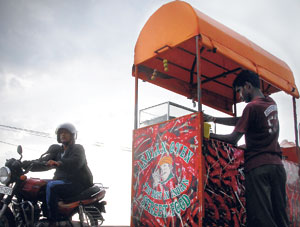Chaat is one of the great, if lesser known delights of Indian cuisine. Its combination of unusual flavours juxtaposes sweet with sour and then throws in some spice. Chaat is essentially Indian fast food, and it’s sold on street corners across the country by bhelwalas.
 |
| Pavan Samtani |
Fresh curd, raw onions, tamarind sauce, boiled potatoes and channa join a host of other flavours. Quick and basic, chaat isn’t five star food, its authentic street food.
That might be one of the reasons chaat is also a rarity in Sri Lanka – but Pavan P. Samtani is determined to change that.
Though he was born a Sri Lankan, Pavan’s parents hail from India. Family recipes have gone into creating the menu for Indian Oven –’ The Best in Indian Street Food’. The North Indian short eats on display are prepped at home and sold from a humble little cart parked by Keells on Marine Drive. It’s easy to zip by, so keep an eye out.
“We’ve kept it small,” says Pavan, adding that he’s now considering a larger outlet, thanks to his expanding customer base. “We began in mid-September last year,” he says, explaining that many of his clientele are of Indian origin, because chaat is still something of a mystery to most Sri Lankans. But business is picking up, and clients do recognize signature items like the samosas and pakoras. Its cheap - almost everything on the menu can be had for under a 100 rupees. Only the pav bhaji (priced at 145/-) costs more. Available only on weekends, it’s a hearty dish, that counts for a full meal.
Remember to set aside your dignity and dive right in. Pavan’s food is a good, if rather basic introduction to chaat. For a connoisseur, it pales in comparison to what one might find in India, but for those who can’t be choosers, here’s a friendly tip: pani puris should be eaten whole, in one quick gulp.
Pani puri: Also referred to as gol gappa or the more endearing gup chup, this is a great staple of chaat menus. Small, round, crisp, hollow puris are stuffed with boiled potatoes or mashed chickpeas, then topped with raw onions and garnished with coriander. A small cup filled with a spicy sauce and another filled with sweet sauce accompany the dish – you’re meant to mix them to your liking and flood your gol gappa with the liquid. You put the entire thing in your mouth, and bite down. Ah, heaven. Pavan’s take keeps the sauce sweet, and the potatoes plain. And since it’s so hard to go wrong with gol gappas, they’re worth a try.
Bhel puri: Bhel puri must always be consumed fresh – it gets soggy if left out too long. The puffed rice snack is served with boiled potatoes, raw onions and tomatoes and doused in a tangy tamarind sauce. Sometimes lime juice is added and the entire thing is garnished with coriander.
Sev puri: Sev puri combine all the best qualities of pani puris and bhel puris, but every bhelwala has his or her own spin on the dish. Sev (crispy, thin strings made of either potato or gram flower) top puris or papadis, and are served along with potatoes and different chutneys. Often a creamy dollop of curd finishes the whole dish off.
Pav bhaji: Pav bhaji when made at home is a real labour of love. Pav (bread) richly lathered in butter is served with a potato based curry. Traditionally this curry includes a variety of vegetables that are mashed down into a thick, delicious curry. Most bhelwalas keep it to tomato and potato though, and its still a must have. The dish is traditionally served with another dollop of melting butter smack in the middle of your bhaji, with a slice of lime and raw onions on the side. |



